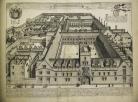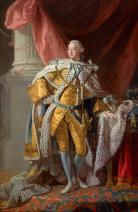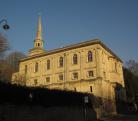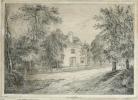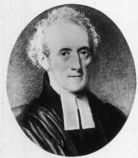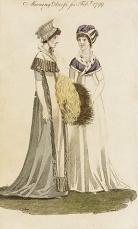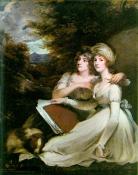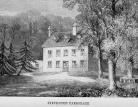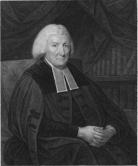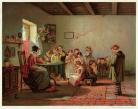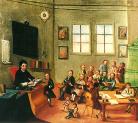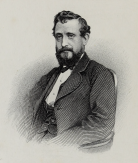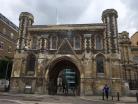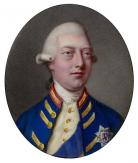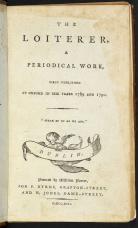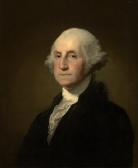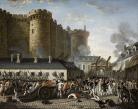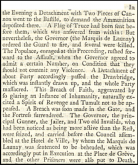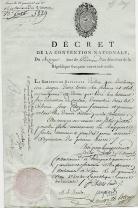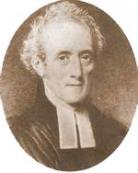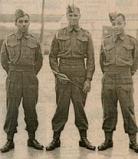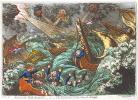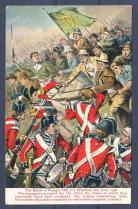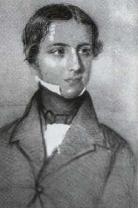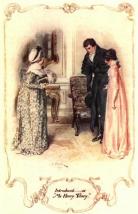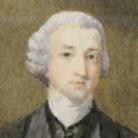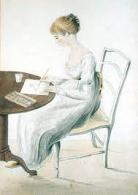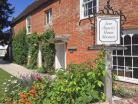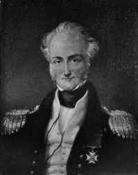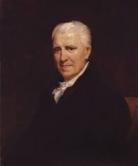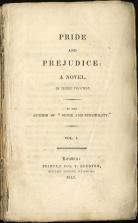Jane Austen Timeline
Created by Bettina Pedersen on Thu, 09/15/2022 - 18:35
Part of Group:

This timeline includes biographical details from Jane Austen's life, including personal events and events related to the writing and publishing of her novels.Dates span her lifetime and include the posthumous publication of her final works.
Timeline
Chronological table
| Date | Event | Created by | Associated Places | |
|---|---|---|---|---|
| 1746 |
George Austen's EducationIn 1746, George Austen, Jane's father, enters into St John's College in Oxford. His education would inspire his passion for education in his own family and his desire to see his children to gain an education. Historians speculate that during this time he met Jane's mother, Cassandra Leigh. This provides insight into the educational background of Jane's father and the way in which he met her mother. “Jane Austen.” Wikipedia, Wikimedia Foundation, 18 Sept. 2022, https://en.wikipedia.org/wiki/Jane_Austen. |
Jennifer Dougherty | ||
| 25 Oct 1760 to 29 Jan 1820 |
Reign of King George IIIKing George III reigned from October 25 1760 to January 29, 1820, the entirety of Austen's life (1775-1817). During this time, he was married to Queen Charlotte of Mecklenburg-Strelitz with whom he had 15 children: George IV (future king of England) (1762), Frederick (1763), William IV (future king of England) (1765), Charlotte (1766), Edward (1767), Augusta Sophia (1768), Elizabeth (1770), Ernest Augustus (1771), Augustus Frederick (1773), Adolphus (1774), Mary (1776), Sophia (1777), Octavius (1779), Alfred (1780), and Amelia (1783). During his reign, America gained independence from England through the American War of Independence, the French had their French Revolution followed by the defeat of Napoleon, and the transatlantic slave trade was banned in England (1807). “George III.” Wikipedia, Wikimedia Foundation, 19 Sept. 2022, https://en.wikipedia.org/wiki/George_III. |
Rachel Kang | ||
| 26 Apr 1764 |
The Wedding of George Austen and Cassandra LeighGeorge Austen and Cassandra Leigh, Austen's parents, married on April 26, 1764, at St.Swithin's Church in Bath. “Jane Austen.” Wikipedia, Wikimedia Foundation, 18 Sept. 2022, https://en.wikipedia.org/wiki/Jane_Austen. |
Rachel Kang | ||
| 1765 |
Moving to SeventonThe Austen family moved to Seventon which is a small village in northern Hampshire recorded to be about 60 miles south of London. This location is where Jane Austen was born and lived most of her childhood and teenage years. |
Lesslye Aparicio | ||
| The start of the month Summer 1771 |
Henry-Thomas Austen's birthOn June 8, 1771, Henry-Thomas Austen was born to Cassandra and George Austen at Steventon in Hampshire County. Henry-Thomas was close to Jane Austen and encouraged her to continue in her joy of writing which drew her to becoming an author. After her death, he worked on publishing her last two novels posthumously in 1817. He also was the first to write Austen's "Biographical Notice," which was published in the first edition of Northanger Abbey and Persuasion. The writing talent in the family was not exclusive to Jane Austen, and Henry-Thomas found himself editor and contributor of The Loiteror for a year. His education and career were well-versed, and he had experience as a banker and clergyman until his death. Austen, Henry, et al. “Appendix C: Ideals of Femininity.” Mansfield Park, 2nd ed., Broadview Press, Peterborough, Ontario, 2003, pp. 484–487. “Henry Thomas Austen.” Wikipedia, Wikimedia Foundation, 15 Oct. 2022, https://en.wikipedia.org/wiki/Henry_Thomas_Austen. Nattress Editor of Austenprose.com, Laurel Ann. “Jane Austen's Siblings – Rev. Henry Thomas Austen 1771-1850.” Austenprose, 3 Mar. 2022, https://austenprose.com/2009/10/06/jane-austens-siblings-rev-henry-thoma.... |
Hope Tyler | ||
| 1772 |
Lady's Monthly MagazineThe Lady's Monthly Magazine published its first issue in 1772. The magazine positioned itself to appeal directly to women. It featured articles on fashion, biographies and portraits of aristocratic persons of interest, essays, and poems. Serialized stories also appeared in the Lady's Monthly Museum, making the publication one of the first to publish novels before they become available as books. Wikipedia contributors. “The Lady’s Monthly Museum.” Wikipedia, 22 Sept. 2022, en.wikipedia.org/wiki/The_Lady%27s_Monthly_Museum. |
Verinia Gillebaard | ||
| 1773 |
Birth of CassandraCassandra was a close companion of Jane Auste. They often wrote letters to each other regarding intimate things about ordinary life such as purchases and refashioning, and gifting. They also reportedly kept no secret from one another and we might have learned more about Jane and their sisterly relationship had Cassandra not burned some correspondance in 1843. At an early age Jane refused to be separated from Cassandra and is speculated that the reason Jane went to boarding school so young was to follow her sister. They were so close that Jane was concerned for her sister's grieving once she died for she was worried that she would be too restrained. |
Lesslye Aparicio | ||
| 1773 |
George Austen's OccupationFrom 1773 until 1796, while living in Stevenson, George Austen supplemented his income by teaching three to four boys at a time who stayed in their home. George is believed to have received an annual income of £200, which speaks to the lower economic status of Austen's family at this time. Although they were considered a part of the gentry, his income was significantly lower than the average gentry income (£1,000 to £5,000). His occupation in teaching speaks to his love of academia and perhaps encouraged his passion for his sons' and daughters' education. “Jane Austen.” Wikipedia, Wikimedia Foundation, 18 Sept. 2022, https://en.wikipedia.org/wiki/Jane_Austen. |
Jennifer Dougherty | ||
| 16 Dec 1775 |
BirthJane Austen was born December 16, 1775, at Steventon Rectory in Hampshire England. Sources say she was born a month late to George Austen and Cassandra Austen (née Leigh). She was the youngest of seven children James (1765), George (1766), Edward (1767), Henry (1771), Cassandra (1773), Francis (1774), Jane (1775) and Charles John (1779). It's recorded that George suffered from seizures and was potentially blind and mute, so his parents put him into foster care. “Jane Austen.” Wikipedia, Wikimedia Foundation, 18 Sept. 2022, https://en.wikipedia.org/wiki/Jane_Austen. |
Rachel Kang | ||
| 4 Jul 1776 |
American IndependenceIn 1776, the US declared independence from Britain, and shortly after, the British went to war with the Americans. Defeat abroad and division at home led many Britons to believe that their country was in irreversible decline. The war had cost more than £236.4 million and had apparently brought only humiliation and the loss of one of the most profitable regions of the British Empire. Yet recovery was rapid, and by the time Britain again went to war—in 1793, against revolutionary France—it was wealthier and more powerful than it had been at the beginning of George III’s reign. 1775 : timeline : articles and essays : documents from the Continental Congress and the Constitutional Convention, 1774-1789 : digital collections : library of Congress. The Library of Congress. (n.d.). Retrieved September 22, 2022, from https://www.loc.gov/collections/continental-congress-and-constitutional-... |
Verinia Gillebaard | ||
| circa. 1777 to circa. 1801 |
Hugh Blair's SermonsHugh Blair was a famous Scottish minister that became vital to the Scottish Enlightenment as a teacher and influential voice in the church and secular regions. Between 1777 and 1801, Blair wrote and published five volumes of sermons highlighting Christian morality. He was considered socially conservative and disapproved of radical change. The sermons reflected those thoughts and corresponded with the intended audience of the upper class. What distinguished his sermons was his focus on morality, faithfulness to God, and a balance of emotion and reason. He experienced great success with the volumes, and they were translated into other languages with five new editions that followed. In Mansfield Park, Mary Crawford’s opinion of a clergyman would be to preach Blair’s Sermons and not his own original work. Her comment nods to the success of the volumes. Austen, Jane, and June Sturrock. “Chapter 10.” Mansfield Park, Broadview Press, Peterborough, Ontario, 2003, p. 127. "Hugh Blair." Wikipedia, Wikimedia Foundation, 3 Nov. 2022, en.wikipedia.org/wiki/Hugh_Blair. Accessed 8 Nov. 2022. |
Hope Tyler | ||
| Spring 1783 |
Boarding SchoolJane (age 7) and her elder sister Cassandra leave for boarding school in Oxford for education on April 1783. The reason why she was sent off to school is unsure, but there are some speculations. One theory is that she wanted to go and accompany her elder sister Cassandra (age 10) and cousin Jane Cooper (age 12) to the Mrs.Cawley's school in Oxford. Due to a "putrid fever" epidemic, the schooling had to be relocated to Southampton in late August. Both Jane and Cassandra caught the illness and their mother was not informed by Mrs. Cawley. Instead, Jane Cooper wrote to her mother notifying her of the developments reagrding the sickness of her cousins to which Mrs. Cooper came to the rescue. Sources differ in understanding whether it was Mrs. Austen or Mrs. Cooper who came to pick the girls up but all agree that Jane Austen nearly died of this illness. |
Lesslye Aparicio | ||
| Summer 1783 |
Putrid FeverThe putrid fever, medically known as typhus, was preavalent in the early life of Jane Austen as there was a Putrid Fever epidemic August of 1783. This disease was brought in by troops incoming from their service in Gibraltar returning and quartering in Southampton. This illness was of high mortality among elder people and historically occured during times of war and famine. The transmission of this disease froms was primarily through human infestations and pests such as lice, ticks, mites, and rat fleas. Symptoms of this illness were constant headaches, high temperature, pink spotting, that rapidly darken all throughout the body excluding the soles of the feet, palms and face. Recovery could be spontaneous or prove to be fatal. |
Lesslye Aparicio | ||
| 1784 |
SchoolingWhen Austen was 9, they attended the Abbey School in Reading. Shortly after enrolling, however, the girls were withdrawn because their father could no longer afford tuition. Though this completed their formal schooling, the girls continued their education at home with the help of their brothers and father. The Austens often read aloud to one another. This evolved into short theatrical performances that Austen had a hand in composing. The Austen family plays were performed in their barn and were attended by family members and a few close neighbors. “Jane Austen Biography.” Chicago Public Library, www.chipublib.org/jane-austen-biography. Accessed 22 Sept. 2022. |
Verinia Gillebaard | ||
| 1784 |
Romantic PoetryIn 1784, James Thomson's book was published, The Poetical Works of James Thomson. Thomson was one of the many revered poets of the Romantic era that led to inspiring the character 'Marianne' in Austen's Sense and Sensibility. William Cowper, another Romantic poet Sense and Sensibility's 'Marianne is said to have read, also had his book published, The Task with Tirocinium, and Selections from the Minor Poems, in 1784. Austen, Jane. Sense and Sensibility. Edited by Kathleen James-Cavan, Broadview Press, 2001.
|
Verinia Gillebaard | ||
| Winter 1786 |
Jane and Cassandra leave Abby SchoolJane Austen attended Abbey School for reading for 18 months. Jane and Cassandra being able to attend school was pretty rare for the time as school was not mandetory for males, and not mandatory as well as quite rare for females. Jane was fourtunate to be born into a family where education was valued, as her father had also attended school, but also she was born into a family where education was seen as a means of life and earning a living. Unfourtunatly the harsh winter caused Mr. Austen's income to dry up, and the Austen girls had to drop out of school in December of 1786. Jane started to write shortly after Abbey School at the age of 12. |
sadie triezenberg | ||
| circa. Autumn 1788 to circa. Spring 1789 |
King George III experiences hypomaniaKing George III suffered from what we now know as bipolar disorder with acute mania. In 1788 he experienced one of his most severe episodes of mania which led to him taking a step back from his responsibility as king. He left many decisions up to his prime minister, William Pitt the Younger. When King George III was experiencing mania, one sign was often a change in his speech and writing. It has been found that he would write much longer, more creative sentences, and that his vocabulary was all-together more colorful. He was also witnessed to talk a great deal until foam would come from his mouth. When he had to withdraw from the public eye, it left people in a bit of a panic, as people did not know who would take over for him, due to his poor relationship with his son. When he withdrew for recovery he would go to Kew.
“What Was the Truth about the Madness of George III?” BBC News, BBC, 15 Apr. 2013, https://www.bbc.com/news/magazine-22122407. |
Allison Nash | ||
| 1789 |
James Austen's first publication of "The Loiterer"In 1789, James Austen's first publication of her periodical The Loiterer was published and released. This periodical was published weekly until 1790. This periodical was a humorous publication written by James and Henry Austen, Jane's brothers, while they were undergraduates at Univerity of Oxford. Their writting styles have some pretty clear similarites to their sister Jane, as they both incorperate humor and wit into their work, as well as getting their message across to their audience. |
sadie triezenberg | ||
| Spring 1789 |
First President of the United StatesThe election of the first United States president, George Washington, and the America's rebellion against the British Monarchy, raised fears among English nobility and upper class that the lower class would revolt and attempt to end the Monarchy. This presidential election, along with the American and French Revolutions, was a reminder of the vulnerability of the English government. History.com Editors. “George Washington.” History.com, A&E Television Networks, 29 Oct. 2009, https://www.history.com/topics/us-presidents/george-washington.
|
Jennifer Dougherty | ||
| 5 May 1789 to 9 Nov 1799 |
The French RevolutionThe French Revolution began on May 5, 1789, continuing till November 9, 1799. It was brought on largely by the immense socioeconomic discrepancy between the lower/working class and the upper class. While poverty, starvation, and death plagued lower-class France, upper-class France, namely the monarchy, King Louis XVII, and Queen Marie Antoinette, lived a lifestyle of extravagant and frivolous luxury. During this time, Napoleon Bonaparte rose to prominence as a successful military leader, and. the Reign of Terror began. On January 21, 1793, King Louis XVII was publicly killed via guillotine in Paris after being found guilty of high treason unanimously. Queen Marie Antoinette was killed in the same manner in the same location on October 16, 1793. This, along with other revolutions, caused fear among the English nobility, leading to changes in fashion, politics, and literature to try and distance themselves from the French. “French Revolution.” Wikipedia, Wikimedia Foundation, 26 Aug. 2022, https://en.wikipedia.org/wiki/French_Revolution. |
Rachel Kang | ||
| Jul 1789 |
Governor, Marquis de Launay massacres 40, is then put to deathIn the summer of 1789, the London Gazette covered news that the governor of Paris, Marquis de Launay had been put to death. He was responsible for the death of 40 protestors outside of the Bastille. He had let them in as long as they promised to not act violently, and then had them all shot down.
The National, Archives. “French Revolution - Source 2.” The National Archives, The National Archives, 29 Oct. 2014, https://www.nationalarchives.gov.uk/education/resources/french-revolutio.... |
Allison Nash | ||
| 1791 to 1794 |
Slavery is Abolished in French ColoniesDuring the beginning of the French Revolution, slavery was to be abolished entierly instead of just the slave trade that occured in France. In 1791, the colony of Saint-Domingue had a slave revolution and by 1793, Britains threatened to invade the colny. Léger-Félicité Sonthonax, the commisoner of Saint-Domingue, promised freedom, so that the French Republican can be strengthed against the Spanish and the British. so on Feburary 4, 1794, the French National Convention aboloshied all slavery in French Colonies. “Law of 4 February 1794.” Wikipedia, Wikimedia Foundation, 11 July. 2022, |
Jorge Sandoval | ||
| 1792 to 1801 |
Henry Austen joins Oxfordshire MilitiaHenry Thomas Austen was the brother of the novelist Jane Austen. He received his education from his father and studied St. John's College. In 1792 he received his bachelor's degree and was going to become a deacon, but in 1793, his plans were dismissed as war occured between England and France. Henry decided to join the Oxfordshire Milita, where they would protect the English Channel from the French Invasion. In 1795, he served under Lieteneant Cornwallis to protect Ireleand from the French, he was able to make connections with the rich and powerful figures which helped him out as he was appointed paymaster, an officer whose duty is to pay wages. His position as paymaster lasted until 1801. “Henry Thomas Austen.” Wikipedia, Wikimedia Foundation, 19 July. 2022, |
Jorge Sandoval | ||
| Winter 1792 |
Cassandra Austen gets engagedIn the winter of 1792, Jane Austen's sister, Cassandra, gets engaged to Rev. Tom Fowle. Jane was the younger sister to Cassandra, so this was very predictable for Cassandra to be married before Jane, but that did not make it easier for Jane. Jane and her sister were very close and were known to frequently write eachother. This "seperation" was not easy for either Jane nor Cassandra. |
sadie triezenberg | ||
| 1793 to 1795 |
Militia Regiments on the South Coast of EnglandIn Pride and Prejudice, it was mentioned that there was a millitia that arrived in England, "At present, indeed, they were well supplied both with news and happiness by the recent arrival of a militia regiment in the neighbourhood; it was to remain the whole winter, and Meryton was the head quarters" (Pride and Prejudice. Austen. pg. 66). As seen in Appendix F of the novel, Militia regiments were deployed in Southern countries of England due to the war with France. Men were drafted by the number from their respective countries. Wealthy men could avoid being drafted by paying a fine. During the winter, The men were stationed on inland towns, Austen's fictional town Meryton being an example. When summer rolled around, the men would be sent to large camps along the coast of England. Thus the soldiers essentially allowed the town folks the latest news of what occured in their country. Austen, Jane. Pride and Prejudice. (First Edition) Edited by Robert P. Irvine, Broadview Press, 2002. (pg. 66, 449) |
Jorge Sandoval | ||
| 1795 to 1796 |
The flirtation of Austen and LefroyThomas Lefroy was the Irish nephew of a family friend, Lefroy attracted Austen's attention when she met him in 1795. She attended parties with him and bragged to her sister Cassandra that they danced and visited several balls. Then in Januray 1796, she wrote to her sister that she will refuse him unless he promises to give away the white coat. It's never clear if the offer was either a dance or even a marriage proposal. Either way, Lefroy moved back to Ireland to become it's most senior judge. Jane Austen was never married in the long run. Erin Blakemore. “Why Jane Austen Never Married.” History.com, 18 Dec. 2017, |
Jorge Sandoval | ||
| Autumn 1796 |
Austen begins writing "First Impressions"In October of 1796, Jane Austen begins writting her novel First Impressions. When she was writting this novel she was at the age of 20.Austen began writing the novel after staying at Goodnestone Park in Kent with her brother Edward and his wife. This novel was a begging draft/edition of what we know as Pride and Prejudice. It is belived that Austen was writting First Impressions as a social commentary on the complex social customs of her time, as well as the pressure of marriage at her times. The title First Impressions eludes to her first version of Pride and Prejudice being more heavily focused on Lizzy Bennet, as she was the charecter who struggled with letting her first impression of people take ahold of her emotions. |
sadie triezenberg | ||
| Dec 1796 |
French Landing In Ireland FailsFrench troops wanted to aid the outlawed Society of United Irishmen in rebelling against the British. The French were immediately taken down and captured by the British once they reached Ireland. Feelings of republicanism were common among countries trying to remove themselves from British rule. MP was written nearly 20 years after uprisings of both France and Ireland aginst Britian. Austen would have been aware of the political unrest these rebellions caused and likely subtly wrote about said issues with deep consideration. "French Invasion of Ireland Fails Through Winter Storms." History Today, |
Jessie Taylor | ||
| 23 May 1798 to Aug 1798 |
Rebellion In IrelandA rebellion led by the Society of United Irishmen started and ended in 1798. It lasted a short 3 months and was fought by many poorly armed soldiers in a poorly organized fashion. Regardless, the death toll numbered within the tens of thousands. The main goal of this rebellion was to proclaim the country independent from Britain and create the Irish Republic. MP was published 16 years after the uprising was put down. Feelings of revolution and unrest were common feelings within the world Austen was writing in at the time. In chapter 2 of MP, Maria and Julia fault Fanny for not knowing geography, particularly relating to Ireland. They tell their mother, "Do you know, we asked her last night which way she would go to get to Ireland; and she said, she should cross to the Isle of Wight. She thinks of nothing but the Isle of Wight, and she calls it the Island, as if there were no other island in the world." Dorney, John. "The 1798 Rebellion – a brief overview." The Irish Story, 28 |
Jessie Taylor | ||
| 11 Autumn 1798 to 23 Nov |
Lovers' Vows was first performed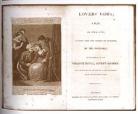 Title page of Elizabeth Inchbald's Lovers' Vows (London: Longman, Hurst, Rees, Orme, and Brown, 1796) Lovers’ Vows is a play translated and adapted by Elizabeth Inchbald from a German playwright August von Kotzebue’s Das Kind der Liebe (1780, literally "Love Child," or "Natural Son.") |
Anna Wang | ||
| Autumn 1800 to 1800 |
Bingley moves to NetherfieldNetherfield was the temporary home to the Bennet family in Pride and Predjudice. Bingley owns the house and this is an important detail to the novel because this estate was were Elizebeth and Darcy first meet. Without Netherfeild, Elizebeth and Darcy probably would have never crossed paths as closely as they did here. |
sadie triezenberg | ||
| Autumn 1801 |
Darcy proposes to Elizebeth (accepted)Darcy proposed to Elizebeth for the second time in Pride and Prejudice, and this time around Elizebeth accepted it. |
sadie triezenberg | ||
| 1802 |
Treaty of AmiensThis Treaty was what stopped the Neopolenic war between France and Britian. During this time France regained most of their colonies. After this treaty took place the size of the militia in Britian shrank tremendously. Change in the malitia may have cheanged hwo the women an military men interacted and may have took some of the stresses of war off of Jane and her brothers.
“French and British Armed Forces.” Encyclopædia Britannica, Encyclopædia Britannica, Inc., https://www.britannica.com/event/Napoleonic-Wars/French-and-British-arme.... |
Jolie Falcon | ||
| 2 Dec 1802 |
Harris Bigg-Wither Proposes to Jane AustenHarris Bigg-Wither proposes marriage to Jane; she first accepts, then withdraws. In 1802, Jane and Cassandra were invited to stay at Manydown by the Bigg sisters Alethea and Catherine, who were the Austen sister's childhood friends. Here Austen spent time with the family and Harris before he proposed to Jane in December. This is the only marriage proposal Jane Austen receives within her lifetime (that we are aware of). She initially accepted his proposal because she had no independent income and was in want of financial security, but the next morning she realized she did not want to go through with it as she did not love him and withdrew her acceptance. Bigg-Wither was 5 years younger than Austen, who was 26 at the time, and he was the second of 9 children. The day after she withdrew her acceptance of his hand in marriage, she and her sister left Manydown to go back home. ("Marriage Proposal from Harris Bigg-Wither." Digital Austen, www.digitalausten.org/node/26. Accessed 14 Nov. 2022.) |
Jessie Taylor | ||
| 1803 |
"Susan" manuscript sold to publisherJane Austen takes the advice of her brother Henry and has his lawyer William Seymour sell her Susan manuscript to the Crosby and Co. publishing place in London. It was sold to them for 10 pounds with a promise to immediately sell it. It never sold from this publishing company but was released as an upcoming book in their advertisements. It shows the difficulties Jane Austen faced selling her books even after her other work was sold successfully. |
Jolie Falcon | ||
| The start of the month Winter 1805 |
George Austen's DeathAfter moving to Bath, Somerset, England, Geroge Austen died at seventy-five from an ilness. The Austen sisters and mothers then relied on their brothers to take care of them. "Rev. Austen was buried in St. Swithin churchyard in Bath. The inscription on his grave reads:
“Jane Austen's Father: Reverend George Austen.” Jane Austen's World, 20 June 2010, https://janeaustensworld.com/2010/06/20/jane-austens-father-reverend-geo... |
Jolie Falcon | ||
| 1805 |
The Theatre RoyalThe Theatre Royal was built in 1805 in Bath, England to replace the Old Orchard Street Theatre. The building was designed by George Dance the Younger. In Persuasion, Charles invites his extended family to join him for a night a the theater: "I have been to the theatre, and secured a box for to-morrow night. A'n't I a good boy? I know you love a play; and there is room for us all" (Austen 233-234). Though he does not directly name the Theater Royal, it can be assumed that he was referring to this theater. "Theatre Royal" Bath." Wikipedia, https://en.wikipedia.org/wiki/Theatre_Royal,_Bath#:~:text=The%20Theatre%.... Accessed 4 December, 2022. Austen, Jane. Persuasion, edited by Linda Bree, Toronto, Broadview Literary Texts, 1998. |
Samantha Rey | ||
| 1806 to 1809 |
The Austen's move to Castle Square, SouthamptonAusten and her family leave Bath and move into a rented house in Castle Square between 1806 and 1809. In 1806, Janes's older brother, Francis Austen, married Mary Gibson. Since Francis was a naval officer and was often away at sea, he said that Mary and his mother, along with Jane, Cassandra, and Martha Lloyd, should share a house together in Southampton. Southampton was surrounded by picturesque countryside and was also close to Portsmouth, where Francis was stationed, so he could return and stay in Southampton often. Portsmouth is also the naval town where the main character of Mansfield Park, Fanny's, immediate family lives. Jane had been to Southampton twice before, once to attend school with her sister and cousin when she was only seven years old (until they all became ill and were taken home), and again when she was eighteen and stayed with her cousin Elizabeth, whose new husband was the Southampton Sherriff. ("Jane Austen in Southampton." Jane Austen's World, janeaustensworld.com/2011/06/ |
Jessie Taylor | ||
| The end of the month Spring 1807 |
Slave Trade Act 1807In 1807, the Parliament of the UK passes an the Slave Trade Act which banned slaves being imported into and traded in England, but it did not prohibit slavery or affect current slave owners within England. This act was one step closer to the abolishment of slavery in England and Europe generally. Slavery would remain legal in England until the passing of the Slavery Abolition Act in 1833. Although this act most likely had no direct effect on Austen or her family, this act had a large impact on the gentry and upper class in England during Austen's life, and perhaps impacted wealthy family members. “Slave Trade Act 1807.” Wikipedia, Wikimedia Foundation, 21 Aug. 2022, https://en.wikipedia.org/wiki/Slave_Trade_Act_1807. |
Jennifer Dougherty | ||
| 1808 |
Poetry PublicationMarmion: A Tale of Flodden Field, a historical romance written in verse about 16th-century Scotland by Sir Walter Scott, was published in 1808. Austen mentions this book of poetry in Persuasion through the character of Captain Benwick, who is "evidently a young man of considerable taste in reading, though particularly in poetry" (Austen 129). Anne and Benwick then discuss which books they favor over others as they get to know one another, which is when Marmion: A Tale of Flodden Field is mentioned (Austen 129).
"Marmion (Poem)." Wikipedia, https://en.wikipedia.org/wiki/Marmion_(poem). Accessed 6 December 2022. Austen, Jane. Persuasion, edited by Linda Bree, Toronto, Broadview Literary Texts, 1998. |
Samantha Rey | ||
| 10 Oct 1808 |
Elizabeth Knight, Fanny Knight's Mom, DiesFanny Knight was 15 when her mother, Elizabeth, died on October 10, 1808. Jane and Cassandra took on a motherly role in Fanny’s life. Shortly after his wife’s death, Edward Knight (Jane’s brother) inherited a property in Chawton, where Jane, Cassandra, and their mother lived in the cottage. Their close proximity strengthened their relationship. Her letters of correspondence in which Fanny asks for advice on whether or not to marry a suitor, could have influenced the content in Persuasion.
Boyle, Laura. “Fanny Austen Knight (Knatchbull).” Jane Austen Centre and the Jane Austen Online Gift Shop, JaneAusten.co.uk, 22 Aug. 2021, https://janeausten.co.uk/blogs/jane-austen-life/fanny-austen-knight-knat... |
Sofie Fransen | ||
| 1809 to 1967 |
The Quarterly ReviewIn 1809, John Murray started The Quarterly Review to describe current public opinions. It became a literary and political periodical that did not stop running until 1967. It did not encourage political reforms and often took a liberal-conservative stance. The Review was sometimes seen as radical and dismissive of other views and used its influence in London to reach the upper class. The periodical experienced several controversies for calling out famous poets, writers, politicians, and novelists. The editors attacked anyone who disagreed with their views and publicly criticized them. Nevertheless, The Quarterly Review was judged as one of the most influential journals of the nineteenth century. Because of the conservative nature of the periodical, many of its articles sought to include a "moral review" of society. Some writers called for an adjustment of the community and British culture. The significance of the journal in the novel demonstrates Austen's awareness of the times and what the political atmosphere was like in the gentry class. It also was a nod to the inclusion of romantic philosophy in the journal that may have impacted her work. Austen, Jane, and June Sturrock. “Chapter 10.” Mansfield Park, Broadview Press, Peterborough, Ontario, 2003, p. 127. "Overview of the Quarterly Review under Gifford (1809-24)." Romantic Circles. Ed. Paul Youngquist and Orrin N.C. Wang. University of Colorado Boulder, 01 Feb. 2005. https://romantic-circles.org/reference/qr/founding/intro.html. Web. 7 Nov. 2022. "Quarterly Review." Wikipedia, Wikimedia Foundation, 23 Jan. 2022, en.wikipedia.org/wiki/Quarterly_Review. Accessed 7 Nov. 2022.
|
Hope Tyler | ||
| 7 Jul 1809 to 18 Jul 1817 |
Jane Austen Moves to Chawton HouseJane Austen moved to the small village of Chawton with her mother, sister, and family friend/best friend Martha Lloyd, on July 7, 1809. Jane spent the last eight years of her life in this house after it was given to the four ladies to share by Edward Austen, one of several brothers in the Austen family. The house is now a major tourist site for Austen enthusiasts, treated as a museum with portraits of the family and various items once belonging to Jane or significant in the history of her life displayed throughout. The house was also the site of Austen's fervent writing -- here is where she was able to revise what is now Sense and Sensibility and eventually get it published. Here is also where she began and completed Mansfield Park, Emma, and Persuasion before her health began to decline. The other parts of novels finished but not completed by her own hand, such as Sanditon, were also worked on here in Chawton. Some of the letters and lines of poetry that remain to detail Jane's thoughts concerning the house and her living there are positive. The neighborhood was known to be small and the lifestyle of the women humble but overall understated and comfortable. Johnson, Ben. “The Real Jane Austen.” Historic UK, https://www.historic-uk.com/CultureUK/The-Real-Jane-Austen/#:~:text=From.... “Jane Austen: A Life.” Jane Austen's House, OPENCULTU.RE, 20 July 2022, https://janeaustens.house/jane-austen-a-life/. |
Meghan Coley | ||
| 10 May 1810 |
Charles Austen Promoted to CaptainPersuasion produces constant references to the merit awarded sailors in the British Royal Navy. Anne says in chapter three, “The navy, I think, who have done so much for us, have at least an equal claim with any other set of men, for all the comforts and all the privileges which any home can give.” If Austen’s voice is aligned with Anne, the fact that two of her brothers were in the Navy, may have influenced her take on Navy men, especially since they dealt with the same historical setting as the characters in Persuasion. Charles Austen, Jane’s youngest brother, was promoted to captain on May 10, 1810 after working his way up in position in the Navy. A few years later, in 1814, he was given command of the HMS Phoenix and was sent to the Adriatic to prevent the escapes of Neopolitan warships after Napoleon’s escape from Elba. “HMS Phoenix (1783).” Wikipedia, Wikimedia Foundation, 6 Nov. 2022, https://en.wikipedia.org/wiki/HMS_Phoenix_(1783). |
Sofie Fransen | ||
| 30 Oct 1811 |
"Sense and Sensibility" Is PublishedOn October 30, 1811, Sense and Sensibility was published by Thomas Egerton in London. Austen was 35 years old when this first novel of hers hit the shelves. The novel was originally titled Elinor and Marianne before Jane sent her manuscript to a publisher only to receive little to no feedback. She turned around and made extensive revisions to bring us the novel we have today and read in this class. Jane did not put her name on the finished product, penning "By a Lady" on the title page, an alias later used to promote the sales of Pride and Prejudice once Sense and Sensibility experienced critical acclaim. Austen eventually, "cleared £140 from the [novel's] first edition, equivalent to £9,000 or more today" (Cavendish).
Cavendish, Richard. “Publication of Sense and Sensibility 'By a Lady'.” History Today, 10 Oct. 2011, https://www.historytoday.com/archive/publication-sense-and-sensibility-%...'s%20Sense%20and%20Sensibility,Egerton%20on%20October%2030th%2C%201811.&text=Jane%20Austen%20was%2035%20when,six%20years%20left%20to%20live.
|
Meghan Coley | ||
| Summer 1812 |
George Crabbe’s Tales was published"Crabbe's Tales" is mentioned in MP on p 175 (2nd ed.) George Crabbe (1754 –1832) was an English poet, surgeon and clergyman. He is best known for his early use of the realistic narrative form and his descriptions of middle and working-class life and people. He is often called the last of the Augustan poets because he followed John Dryden, Alexander Pope, and Samuel Johnson in using the heroic couplet, which he came to handle with great skill. He was admired by Byron and the Romantic poets, as well as Jane Austen. Quotes: "The game is never lost till won." "Better to love amiss than nothing to have loved." |
Anna Wang | ||
| 18 Jun 1812 to 17 Feb 1815 |
The War of 1812In Mansfield Park, Tom asks Dr. Grant, “A strange business this in America, Dr. Grant! What is your opinion? I always come to you to know what I am to think of public matters” (2nd ed., p141). This “strange business” in America could be referred to the War of 1812. The War of 1812 was the conflict fought between the United States and Great Britain over British violations of U.S. maritime rights. It ended with the exchange of ratifications of the Treaty of Ghent. Some regard the American Revolution War and the War of 1812 two wars of liberation. If the American Revolution was the birth of the United States, the War of 1812 was its coming of age.
|
Anna Wang | ||
| 28 Jan 1813 |
First Edition of Pride & Prejudice PublishedJane Austen sold the copyright of Pride and Prejudice to Thomas Egerton from the Military Library, Whitehall for 110 pounds. Egerton published the first edition of Pride and Prejudice in three hardcover volumes on January 28, 1813. It gained many positive reviews that caused the first edition to sell out with a second edition published in October of that same year. The novel was still published anonymously, but was attributed in this first edition as "the Author of Sense and Sensibility". “Pride and Prejudice.” Wikipedia, Wikimedia Foundation, Dec. 2022, https://en.wikipedia.org/wiki/Pride_and_Prejudice. |
Emma Peters | ||
| 1814 |
Mansfield Park PublicationMansfield Park is the third novel by Jane Austen. The first edition was published in 1814 by Thomas Edgerton, and the second edition was published in 1816 by John Murray, who also founded The Quarterly Review. Austen published the novel in three volumes, and it is considered the most serious of her novels. This novel never received critical reception until 1821. She wrote Mansfield Park while living in Chawton, and the announcement that the writer of Sence and Sensibility and Pride and Prejudice would be publishing another novel caused the readers to buy out Austen’s third novel in six months. The controversy over the novel’s themes and main characters, particularly Fanny Price, left audiences feeling that Pride and Prejudice remained superior and most favored the brilliance of her second novel. Austen herself stated the novel would not be half as great as the success of her second. Although the novel has sparked debate over its plot and characters for two hundred years, it remains to be a heartwarming narrative delivered by one of the most significant literary geniuses of the 19th century. Austen, Jane, and June Sturrock. “Jane Austen: A Brief Chronology” Mansfield Park, Broadview Press, Peterborough, Ontario, 2003, p. 30. “Mansfield Park.” Jane Austen Society of North America, Jane Austen Society of North America, https://jasna.org/austen/works/mansfield-park/. |
Hope Tyler | ||
| 11 Apr 1814 to 26 Feb 1815 |
Napoleon's First ExileThe armies of the Coalition (which included the United Kingdom) had entered France by 1814 and were on the march to Paris, which meant that Napoleon was forced tot abdicate. The Coalition leaders drew up the Treaty of Fontainebleu, which exiled Napoleon to the island of Elba where he was only allowed to have control over this island. Napoleon stayed on the island of Elba for about a year, until he managed to escape on February 26, 1815. The novel is set in the year 1814, before Napoleon had escaped and it seemed that France had been defeated. The novel indirectly structures itself by this war, as it shows the success of Captain Wentworth who was able to gain wealth and raise ranks in the war against Napoleon and come back more successful by 1814. Although Napoleon's first exile seemed like a victory for England, they will have to go back to war when Napoleon escapes in 1815. This would have been something that Austen and readers were aware of while reading this novel, and is something to consider when Anne's happiness at being a sailor's wife is described at the end of the novel. She says that, "His profession was all that could ever make her friends wish that tenderness less, the dread of a future war all that could dim her sunshine" (Austen 258). Napoleon's first exile is not his last one, and Austen reveals what is to come with the foreboding tone at the conclusion of the novel. Griffiths, Jack. “Lieutenant Frank Alexander De Pass: Hero of History.” All About History, Future Inc., 21 Nov. 2014, https://www.historyanswers.co.uk/history-of-war/lieutenant-frank-alexand.... Looser, Devoney. “How the French Revolution Influenced Jane Austen's Works.” Wondrium Daily, Wondrium, 9 Sept. 2022, https://www.wondriumdaily.com/how-the-french-revolution-influenced-jane-.... |
Emma Peters |

